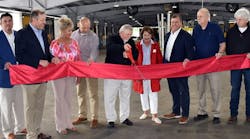The growth of online shopping, direct-to-consumer shipping and so-called “omni-channel” distribution demands is generating big amounts of change for the third party logistics (3PL) industry – to the point where the number of 3PLs overall may shrink significantly, in the main through mergers and acquisitions.
“Logistics is no longer focused just on pushing goods from distribution centers to big box stores; now we’re going direct to consumer homes and that’s changing the logistics dynamic significantly,” Robert Nathan, CEO of Load Delivered Logistics (LDL), explained to Fleet Owner.
“E-commerce is creating this whole new dynamic in transportation that many traditionally-structured 3PLs are having a hard time adapting to; especially those focused narrowly in scope on full TL and LTL delivery networks,” he noted.
A recent story in Forbes magazine chronicled one major ripple effect on 3PLs from such changes: a spate of buyouts and acquisitions as the biggest logistics players seek to gain more scale in order to handle demands for more “omni-channel” distribution needs.
LDL’s Nathan expects that trend will result in the top 200 3PLs in the U.S. collapsing down to about 50 by 2020 as a result of the growth in such new logistical “patterns.”
“Especially over the next 36 months I think we’ll really see an accelerated pace of acquisitions, followed by more mergers” he added. “And it’s all going to part of this move away from just thinking about logistics from a ‘multi-modal’ perspective to a more ‘holistic’ view that start’s with a simple premise: how the consumer is buying goods.”
John Larkin, managing director and head of transportation capital markets research for Wall Street firm Stifel, Nicolaus & Co., noted in a recent speech that e-commerce is completely changing what he called the “world of distribution.”
“Currently about 9% of total retail sales occur via e-commerce [and] it seemed like 90% of that, by the way, moved in the five days before Christmas this year and covered up the great UPS,” he noted. “Whoever thought that UPS would have so much freight in its system that it basically choked the ‘Big Brown’ machine? That was quite a unique event that we experienced this past December."
Yet Larkin stressed that e-commerce is growing at 15% per year or about five times the rate of growth of the brick and mortar stores, which make up the rest of retail sales.
That’s why in his view “omni-channel distribution” is a becoming a much bigger topic of discussion. “How does Wal-Mart, whose DCs [distribution centers] are out in the middle of nowhere, compete with Amazon, who is putting their fulfillment centers in the middle of big, urban markets? How much or how little automated picking should be implemented in fulfilling these orders?” he asked.
And then there is the same day deliver phenomenon, Larkin stressed.
“How do you fulfill the order of a customer who places an order at ten in the morning and would like that product delivered at two in the afternoon? UPS and FedEx aren’t really set up to handle that,” he noted. “It looks like Amazon is going to have their own private fleet to accomplish that in the top 40 markets. They are going to use local delivery companies in the next biggest 60 markets and then they will use FedEx, UPS, and the Postal Service in the rest.”
For those reasons, LDL’s Nathan thinks two major shifts in the 3PL business will occur over the next few years. The bigger players will seek to get bigger – building scale to provide more such “omni-channel” services in more markets – while smaller players will focus on providing more niche services, relying heavily on technology and not manpower to craft the right logistics solutions.
“Technology is what will make a 3PL more agile, especially in terms of e-commerce; it’s what will allow a 3PL to integrate with an online shopping cart,” he pointed out. “Six to eight years ago this kind of technology and this kind of shopping pattern didn’t exist – and it’s why traditional logistics services won’t necessarily provide the right solutions.”



